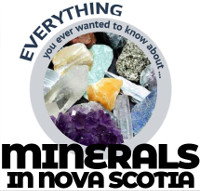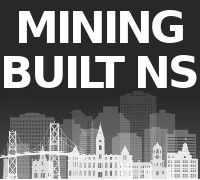- Why Mining Matters
- Jobs
- Safety
- Environment & Operations
- FAQ
- Links
- Fun Stuff
You are here

Gallihar and Dimock
Mr. Death
The Guilty Grenos
James Mitchell
Hugh McAskill
Gold Grows Under Shrubs?
Unexploded Dynamite
Tangier’s John Murphy
Joe Howe Dimock
Chats with Pioneer Miners
Charles Annand
John Scott Williams
Nicholas Fitzgerald
Chief Lonecloud
Pistols and Gold Mines
James MacDonald’s Thefts
John Vaughn
Herbert Dixon and the Halifax Explosion
James Bishop
Neily's Scandals
Waverley in 1934
Discovery of Gold at Dufferin
Hurricane Island
Fletcher and Faribault
Jack Munroe
Mine Apprentice Project
Small Gold Districts
15 Mile Stream
Tributers
E. Percy Brown and the Brookfield Mine
Barachois
Nova Rich Mines
Shad Bay Treasure Hunt
Montague 1937 Accident
Father Lanigan’s “Prospect”
George V. Douglas
The Stewart Brothers
Goldboro
Moose River's Touquoy Mine
Camerons Mountain
Jim Campbells Barren
Stanburne's Puzzling Gold Mine
Pockwock
Beaverbank Lake
Banook Mining Company
Deep Gold Mining
Wellington
Arsenic and Gold
Dynamite
War of Words
King of the Klondike
Oliver Millett
Kempt Gold Mining Company
Carleton
The Memramcook Fiasco
Love and Gold in Oldham
Montague 1893 Disaster
Central Rawdon Consolidated Mines
Cochrane Hill
Amateurish Early Gold Mining
Sable Island Gold
The Sea Wolf
Trueman Hirschfield
Alexander Heatherington
Prospector Joe Cope
Killag Quicksand
George W. Stuart
Wellington
Billy Bell
Cooper Jim Mine
South Branch Stewiacke
Walter Prest
Lake Charlotte
Acadia Powder Mills Company
The Ovens Anticline
Moose River Anticline
Avon Mine Explosion
Montague
Waverley Claims Dispute
Avon River
Moose River Disaster
Mooseland Scam
New York and Nova Scotia Gold Mining Company
Rosario Siroy and the South Uniacke Gold District
Blockhouse
Killag Gold District
Miller Lake
Baron Franz von Ellershausen
Mooseland: Nova Scotia’s first Gold Discovery
United Goldfields of Nova Scotia
Pleasant River Barrens Gold District
Lochaber Gold Mining Company
Rawdon Gold Mines
MacLean Brook
Gold in Clayton Park?!
Forest Hill
Meguma vs. Placer Gold
Uniacke
Voglers Cove
Gold River
Moosehead
Goldenville
Westfield
Indian Path
Harrigan Cove
Centre Rawdon
Nova Scotia’s Gold Mining History
WWII Gold
Middle River Gold District
Early Gold Discoveries
Halifax 1867
Paris Exhibition 1867
Mining and Tourism
An Act relating to the Gold Fields
Molega Gold District
Brookfield Gold District
Gays River
Halifax Gold
Caribou Gold District
Renfrew Gold District
Oldham Gold District
Whiteburn Gold District
Country Harbour Mines
Waverley Gold District
Robert Henderson and Klondike Gold
George Mercer Dawson
Cow Bay Gold District
Lake Catcha Gold District
Wine Harbour Gold District
Gallihar and Dimock
In 1904, two men died as a result of working at a gold mine in Lower Seal Harbour, but the tragedy was not directly caused by mining.
On October 24, William Gallihar and Edward Dimock left their homes early in the morning and headed to a small bridge that crossed a river or stream which the Halifax Herald referred to as the “Upper Seal Harbour run.”
Gallihar and Dimock were sent to dismantle the bridge because its planking was needed for cribbing in a temporary mine shaft.
The men did not return home at the end of the day, so friends went looking for them.
The Herald wrote, “Not finding them last evening a larger party resumed the search at daybreak, and their caps were found floating in the water. The party began dragging for the bodies, and recovered them about nine o’clock, both near together in nine feet of water. No one knows how the accident occurred.”
According to the newspaper, “William Gallihar is a son of the late Charles Gallihar, who at one time carried on a large general business in this place. Edward Dimock belongs to Waverley, Halifax County, and has lived here for the past twelve years. Much sympathy is felt for the bereaved families.
Nova Scotia’s mining and quarrying industry has reduced its injury rate by 90% since the Westray inquiry report was released in 1997 and is one of the safer industries in the province today. We believe the most important thing to come out of a mine is the miner, and our modern safety record reflects this.
The story of Gallihar and Dimock is a sad reminder of why we have the same commitment to safety in all aspects of our operations, both at mines and quarries and offsite - for example, when transporting minerals and equipment.
Gallihar and Dimock worked for Percy J. White, who earlier that month had discovered the main lode in Lower Seal Harbour when he followed several previously discovered gold-bearing veins and found that they were part of a larger belt of veins. White’s discovery was close to the boundary line between his property and that of G. J. Partington to the west. Almost immediately after White’s discovery, Partington discovered the same ore body on his side of the line.
The rush of activity in Lower Seal Harbour that followed White’s find was no doubt the reason Gallihar and Dimock were sent to fetch the wood from the bridge.
Like so many of Nova Scotia’s historical gold districts, Lower Seal Harbour has the potential to be returned to production and to create jobs for Nova Scotians. In fact, almost all the activity in Nova Scotia’s gold sector is at historical mines where deposits were proven during our early gold rushes, but modern science and technology make it possible to mine profitably while, of course, taking proper care of the environment.

















































































